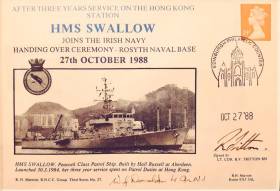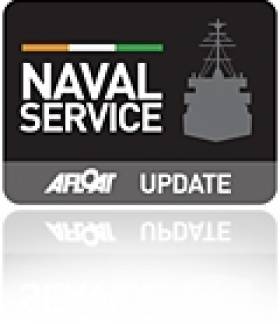Displaying items by tag: Peacock Class
Former Hong Kong 'Peacock' Pair Pass 30 Years of Operations With Irish Naval Service
#NavalService - A pair of Peacock class UK Royal Navy patrol vessels that had been based in Hong Kong, were handed over to the Irish Naval Service 30 years ago, writes Jehan Ashmore.
The pair LÉ Orla (video) the former HMS Swift (P243) and sister LÉ Ciara, ex HMS Swallow (P243) built by Hall Russell & Co (no longer in business) Scotland were commissioned for the Royal Navy. They patrolled the waters of the British colony that would itself be handed over to China in 1997.
The sleek profile pair built in 1984/5 were part of an order for five coastal patrol vessels (CPV) on station at Hong Kong. They were specifically built to serve in the RN's Hong Kong Patrol Squadron, however the pair only served three years before been brought by the Irish Government at a price considered to be a bargain, given they were almost new.
Apparently, there was friction over the acquisition of the CPV's, between the RN and the UK Government, as the navy did not have enough such vessels of this size operating in homewaters.
It was also then rumoured the reasoning for the transfer of the CPV's to the Irish Government was due to the ongoing troubles in Northern Ireland and that of security concerns. At the time, the UK prime minister was Margaret Thatcher, leader of the Conservative Party.
The handover ceremony of the CPV's between the UK and Irish navies took place on 27 October 1988 and aptly took place back at their birthplace in Scotland, albeit at the Rosyth Naval Base on the Firth of Forth.
Following the delivery voyage of the CPV's from Scotland, it was during the following month, that an impromptu invite arose to visit the Irish Naval Service base in Cork Harbour.
Moored abreast in the Naval Base basin was LÉ Orla and LÉ Ciara. Boarding took place that led to a busy scene as crew and contractors prepared the ships into the fleet, which increased to 7 patrol ships. Among them the Irish built flagship of the Irish Naval Service, the HPV LÉ Eithne, likewise the same age of the CPV's.
On the visit, at that stage the CPV's had already been given the new names, albeit unofficially the pair had not been commissioned into service. The LÉ Orla and LÉ Ciara proudly reflecting Irish mythological women's names given to the navy vessels, a tradition that (until more recent years) stretched to the foundation of the Irish Naval Service in 1946.
The Taoiseach, C.J. Haughey of Fianna Fail, in January 1989 paid a visit to the CPV's to commission the secondhand tonnage into service at the Naval Base on Haulbowline Island, itself a former Royal Naval Base in lower Cork Harbour.
Each of the CPV displacing 712 tons, have a crew compliment of 39 personnel (5 officers). The main armament is a 76mm OTO Melara Canon using a Radamec Fire Control System. As for propulsion plant, this is a Crossley SEMT- Pielstick Diesels delivering 14,400hp through two shafts and a speed of 25 knots plus.
Due to their high speed, the pair's shallow draught (2.7m) made these vessels ideal for patrolling close to the rugged coastlines notably on the western seaboard. During the CPV's careers, they have been involved in some of the largest seizures of arms and narcotics in the history of this State.
According to the Defence Forces website, a notable operation of LÉ Orla took place in 1993 when the CPV conducted the biggest drug seizure in the history of the state at the time. This involved the interception and boarding at sea of the 65ft ketch, Brime.
As for LÉ Ciara, the small ship scored a notable operational success as in 1999, the CPV conducted the second biggest drug seizure in the history of the state at that time. The incident saw an interception and boarding at sea of MV Posidonia of the south-west coast.
The pair however as Afloat reported in 2015 were out of commission for several months due to airborne asbestos being discovered in the engine rooms but all such dangerous material was removed. Also reported that year, the sisters during normal refit work at Cork Dockyard, underwent remedial work done on the funnels, cranes and air-handling units.
Anglo-Irish Relationships
#NAVAL VISITS- HMS Tyne (P281) the leadship of four River-class Fishery Protection Vessels is due to dock in Dublin Port tomorrow, in the meantime her allocated berth is currently taken by a former Royal Navy (RN) vessel now serving in the Irish Naval Service (INS), writes Jehan Ashmore.
The INS L.É. Ciara (P42) docked at Sir John Rogersons Quay (berth No.8) yesterday evening after spending the previous day with a call to Dun Laoghaire Harbour's St. Michaels Wharf. Tomorrow she is due to depart in advance of HMS Tyne's morning arrival.
Unusually she and her three sisters are leased to the RN from BAE Systems (who retain responsibility for any major maintenance and upkeep) and shipbuilding partners, Vosper Thornycroft, Southampton which built all of the River-class. To read more about the quartet click HERE.
L.É. Ciara was originally launched as HMS Swallow (P242) at Hall Russell Shipyard, Aberdeen and in 1984 was commissioned for the RN, forming one of five 'Peacock' class coastal patrol vessels (CPV). She served her entire RN career with sisters designed specifically for the Hong Kong Squadron.
In 1988 the INS purchased her alongside a sister HMS Swift (P243) and the pair set sail from the UK colony for Cork Harbour. L.É. Ciara and her sister which became L.É. Orla (P41) were commissioned into the service after a ceremony performed by An Taoiseach C.J. Haughey at the Naval Base in Haulbowline.
Amongst the eight-strong INS fleet is L.É. Emer (P21) commissioned in 1978, an improved version of the Deirdre-class offshore patrol vessel (OPV). She appeared along with a sister of the River-class ship, HMS Severn in the Irish language river series 'Abhainn' which returned to our screens on RTE 1 last month, during the episode about the River Foyle /An Feabhal. The naval vessels were attending 'Foyle Days' in May as previously reported on Afloat.ie
- Irish Naval Service
- Dublin Port
- naval service
- Royal Navy
- Dun Laoghaire Harbour
- Peacock Class
- Hall Russell
- Foyle Days
- Naval Visits
- River Foyle
- Coastal Patrol Vessels
- HMS Tyne
- RN
- INS
- Hong Kong Squadron
- Fishery Protection Ship
- BAE Systems
- Vosper Thornycroft
- Haulbowline Naval Base
- Deirdreclass
- Abhainn TV series
- HMS Severn
- Irish River TV series Abhainn
Navy Escort Detained Trawler to Castletownbere
Less then a month ago the Naval Service detained a Northern Irish registered fishing vessel the Lynn Marie seven miles east off Bray Head. Onboard was a crew of 4 UK nationals who were taken into custody to the Gardai after the trawler was escorted by the CPV L.E. Orla to Dun Laoghaire Harbour. To read more about this detention click here.
Ironically the L.E. Orla was a former Royal Naval vessel, HMS Swift (P241) which was deployed on her first assignment to the Hong Kong Patrol Squadron for a four-year period. In 1988 Margaret Thatcher's Conservative Party Government disposed HMS Swift and HMS Swallow (P242) to the Irish Naval Service. The pair were built by Hall Russell Shipyard of Aberdeen as part of an eight 'Peacock' class coastal patrol vessel (CPV).
The 'Peacock' pair were commissioned into the Naval Service and renamed L.E. Orla (P41) and L.E. Ciara (P42) in a ceremony attended by An Taoiseach Charles J. Haughey at the Naval Base in Haulbowline, Cork Harbour.
This weeks' detention is the second conducted by the Naval Service in 2011. Last year the Naval Service carried out 1,666 vessel boardings which resulted in 70 warnings and eight detentions.
- Irish Naval Service
- Cork Harbour
- Northern Ireland
- Haulbowline
- castletownbere
- naval service
- LE Niamh
- Royal Navy
- Ports and Shipping News
- Lynn Marie
- Fishery Breaches
- Fishery Detention
- Fishing Trawler
- Peacock Class
- Hong Kong
- Hall Russell
- Appledore Shipbuilders
- LE Orla
- HMS Swift
- LE Ciara
- HMS Swallow
- Margaret Thatcher
- Conservative Party
- An Taoiseach
- Charles J. Haughey
- Naval Base


























































